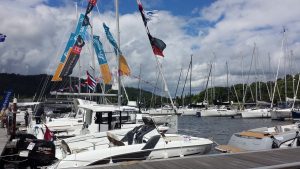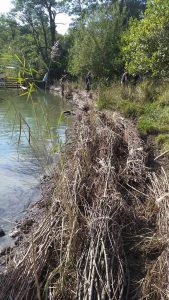Windermere & Leven: Main Issues
Water Quality
- Since 2000 there has been a notable decline in lake conditions. This has been linked to increases in phytoplankton, increasing summer algal-blooms and depletion in oxygen concentrations in the deeper parts of the lake.
- Concerns on the effects of increasing nutrient levels and its impact on species within the lake have been raised since the 1980s.
- A combination of factors have contributed to the decline in water quality including inputs from septic tanks, land run-off, storm discharges, boat spillages and sewage treatments works.

Windermere Boat Show
- Bank poaching by livestock is common particularly in the upper catchment contributing to increased sediment loads and nutrients entering the rivers and lakes.
- Water quality also plays a major part in tourism. It can impact upon the visual appearance, clarity of the water, plant and animal life and these in turn affect recreation and enjoyment of the lake. Therefore, high water quality is an asset and vital part of the local economy.
- Historic copper mines at the top of the Little Langdale Valley contribute heavy metals into the system.
Flooding and Drought
- Major flooding affected the catchment in October 2008, November 2009 and December 2015.
- It is thought that approximately half the river reaches in the catchment have good floodplain connectivity. However, a fifth of reaches are disconnected from their flood plains, channelling water downstream at a faster rate. A further fifth of the reaches do not have a distinct floodplain due to valley shape.
- Droughts affected the catchment during the spring and summer of 2010.The consequent fall in lake levels impacted on the recreational and commercial use of the lake.
- United Utilities are able to abstract water from the lake for distribution throughout Cumbria and the North-West. During times of drought this has to be reviewed and water shortages may occur.
Physical Modifications
- There are 28 weirs and 19 culverts through-out the catchment.
- Modifications are evident across the catchment including on the River Rothay through Grasmere and Stock Ghyll through Ambleside.
- Great Langdale Beck was canalized between 1954 and 1958.

Reedbed planting
Lack of Habitat
- Reedbeds are an important part of the landscape character of the lake. However, reedbeds have declined about 90% in recent years across Windermere. They are threatened from actions such as wave wash from boat bow waves, damage from boat and canoe launching/ paddling, nutrient enrichment and grazing from Canada Geese, ducks and farm animals.
- Freshwater Pearl Mussels were once prevalent in this catchment however, due to declines in habitat and water quality there is now only a very small remnant population left.
Invasive Species
- Himalayan Balsam, Japanese Knotweed, American Skunk Cabbage, Giant Hogweed and New Zealand Pigmyweed (Crassula) are all present in the catchment as well as a number of invasive fish species.
- Dramatic declines in the number of Arctic Charr in Windermere have been observed over the last 10 years. This is often linked to increases in populations of non-native fish, such as roach.
- Canada Geese are also a non-native species and can cause damage to agricultural land and contribute phosphorus to the lake. Grazing by geese also contributes to the damage and loss of reedbeds and other habitats.
For more information please take a look at our catchment maps.
